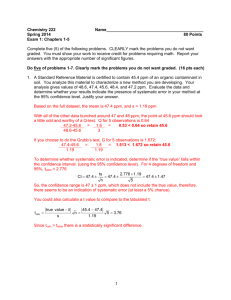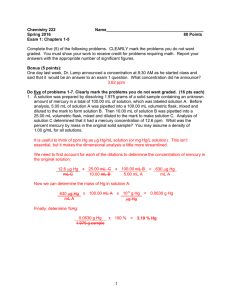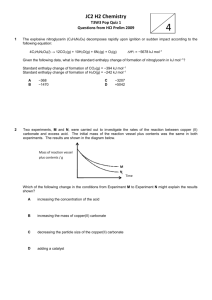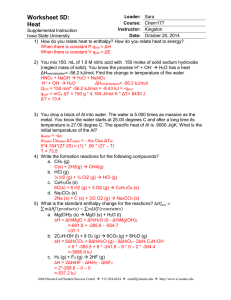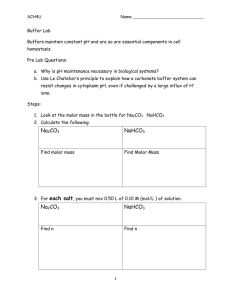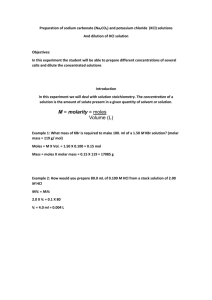You must show your work to receive credit for problems... with the appropriate number of significant figures. Chemistry
advertisement
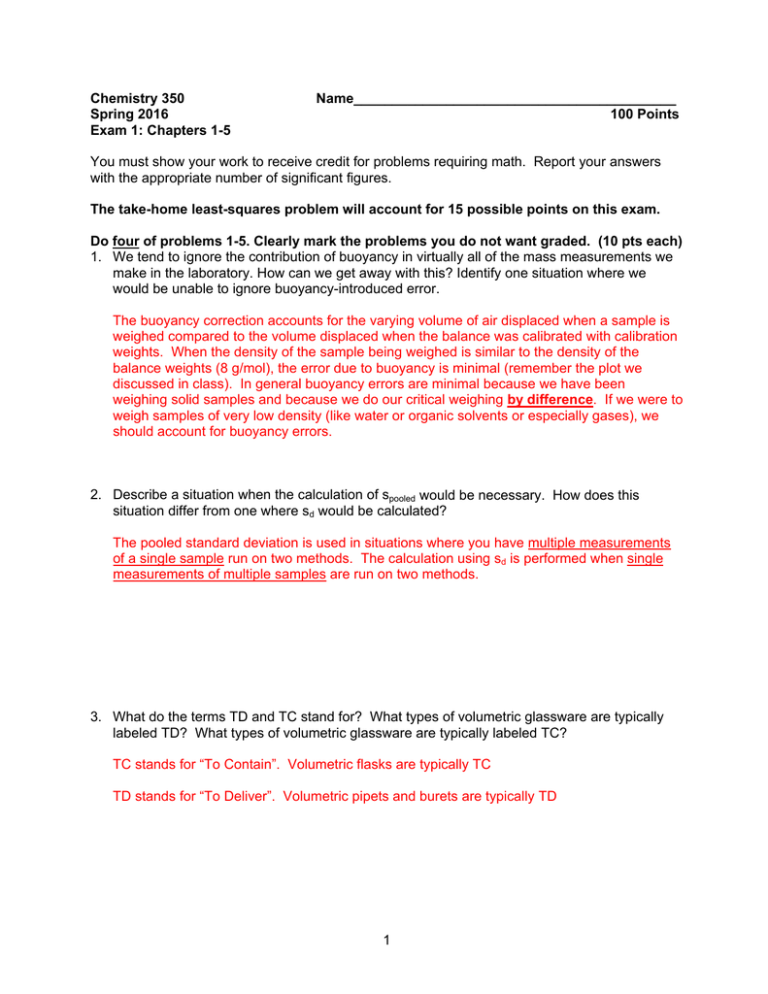
Chemistry 350 Spring 2016 Exam 1: Chapters 1-5 Name__________________________________________ 100 Points You must show your work to receive credit for problems requiring math. Report your answers with the appropriate number of significant figures. The take-home least-squares problem will account for 15 possible points on this exam. Do four of problems 1-5. Clearly mark the problems you do not want graded. (10 pts each) 1. We tend to ignore the contribution of buoyancy in virtually all of the mass measurements we make in the laboratory. How can we get away with this? Identify one situation where we would be unable to ignore buoyancy-introduced error. The buoyancy correction accounts for the varying volume of air displaced when a sample is weighed compared to the volume displaced when the balance was calibrated with calibration weights. When the density of the sample being weighed is similar to the density of the balance weights (8 g/mol), the error due to buoyancy is minimal (remember the plot we discussed in class). In general buoyancy errors are minimal because we have been weighing solid samples and because we do our critical weighing by difference. If we were to weigh samples of very low density (like water or organic solvents or especially gases), we should account for buoyancy errors. 2. Describe a situation when the calculation of spooled would be necessary. How does this situation differ from one where sd would be calculated? The pooled standard deviation is used in situations where you have multiple measurements of a single sample run on two methods. The calculation using sd is performed when single measurements of multiple samples are run on two methods. 3. What do the terms TD and TC stand for? What types of volumetric glassware are typically labeled TD? What types of volumetric glassware are typically labeled TC? TC stands for “To Contain”. Volumetric flasks are typically TC TD stands for “To Deliver”. Volumetric pipets and burets are typically TD 1 4. Whenever we use a confidence interval to represent the proximity of our results to the “true” value, we are forced to make an important assumption. What assumption must be made to use such a statistical analysis to reflect the accuracy of a measurement? Why is this assumption necessary? The confidence interval also allows us to make some inferences about the accuracy of a method by taking the fact that we have a small data set into account; assuming only random errors are impacting our measurement. Therefore, we must rely on good experimental design to remove systematic errors to make an evaluation using the confidence interval reasonable. 5. Outline the process that would typically be used in lab to perform a standard additions experiment. (hint: you will need more than two solutions) Prepare a series of solutions, each containing the same amount of your unknown solution and "spiked" with a different (and known) concentration of analyte (including "0") Perform analysis using each solution Plot signal vs. added analyte concentration Calculate least-squares line Extrapolate the line to the x-intercept. The unknown concentration in the measured solution corresponds to the value at the x-intercept. Account for any dilutions to determine the analyte concentration in your original unknown solution. 2 Do three of problems 6-9. Clearly mark the problems you do not want graded. (15 pts each) 6. A solution was prepared by dissolving 1.975 grams of a solid sample containing an unknown amount of mercury in a total of 100.00 mL of solution, which was labeled solution A. Before analysis, 5.00 mL of solution A was pipetted into a 100.00 mL volumetric flask, mixed and diluted to the mark to form solution B. Then 10.00 mL of solution B was pipetted into a 25.00 mL volumetric flask, mixed and diluted to the mark to make solution C. Analysis of solution C determined that it had a mercury concentration of 12.6 ppm. What was the percent mercury by mass in the original solid sample? You may assume a density of 1.00 g/mL for all solutions. It is useful to think of ppm Hg as g Hg/mL solution (or mg Hg/L solution). This isn’t essential, but it makes the dimensional analysis a little more streamlined. We need to first account for each of the dilutions to determine the concentration of mercury in the original solution: 12.6 g Hg x 25.00 mL C x 100.00 mL B = 630 g Hg mL C 10.00 mL B 5.00 mL A mL A Now we can determine the mass of Hg in solution A: -6 630 g Hg x 100.00 mL A x 10 g Hg = 0.0630 g Hg mL A g Hg Finally, determine %Hg: 0.0630 g Hg x 100 % = 3.19 % Hg 1.975 g sample 3 7. Low concentrations of thallium near the detection limit gave the following dimensionless instrument readings: 211.3, 178.9, 168.3, 180.3, 225.3, 166.1, 229.1, 207.7, 140.7, and 211.5. Ten blanks had a mean reading of 43.9. The slope of the calibration curve is 1.10×109 M–1. Estimate the detection limit for thallium. The average of the measurements is: 191.92 The standard deviation is: 29.17. We assume the standard deviation of the blanks is the same So, the signal at the detection limit is: yLOD = yblank + 3sblank yLOD = 43.9 + 3(29.17) = 131.4 We can use the slope to convert this to a concentration: LOD = 131.4/(1.10x109 M-1) = 1.19x10-7 M 4 8. A Standard Reference Material is certified to contain 45.4 ppm of an organic contaminant in soil. You analyze this material to characterize a new method you are developing. Your analysis gives values of 47.8, 47.4, 45.6, 48.4, and 47.2 ppm. Evaluate the results for suspect data and determine whether your results indicate the presence of systematic error in your method at the 95% confidence level. Justify your answer. Based on the full dataset, the mean is 47.2 ppm, and s = 0.97 ppm With all of the other data bunched around 47 and 48 ppm, the point at 45.6 ppm should look a little odd and worthy of a Q-test. Q for 5 observations is 0.64 47.2-45.6 = 1.6 = 0.64 is not > 0.64 so retain 45.6 48.1-45.6 2.5 If you choose to do the Grubb’s test, G for 5 observations is 1.672: 47.2-45.6 = 1.6 = 1.649 < 1.672 so retain 45.6 1.19 0.97 To determine whether systematic error is indicated, determine if the “true value” falls within the confidence interval. (using the 95% confidence level). For 4 degrees of freedom and 95%, ttable = 2.776 2.776 0.97 ts CI 47.2 47.2 47.2 1.20 n 5 So, the confidence range is 47 ± 1 ppm, which does not include the true value, therefore, there seems to be an indication of systematic error (at least a 5% chance). You could also calculate a t value to compare to the tabulated t: t calc true value x s n 45.4 47.2 0.97 5 4.15 Since tcalc > ttable there is a statistically significant difference. 5 9. Acid solutions can be standardized using primary standard sodium carbonate, much like base solutions can be standardized using pure KHP as we did in lab. Below is data from a titration of a sodium carbonate sample with a solution of hydrochloric acid of unknown concentration. In this titration, approximately 25 mL of distilled water was used to dissolve the sodium carbonate that was dispensed from the weighing bottle into an Erlenmeyer flask. What is the molarity of the hydrochloric acid solution with its absolute uncertainty? Initial mass of weighing bottle and sodium carbonate Final mass of weighing bottle after sample was removed Initial buret reading Final buret reading Molar mass of sodium carbonate 32.13840.0002 g 30.96150.0002 g 2.380.02 mL 39.540.02 mL 105.98850.0002 g/mol Our reaction of interest is: Na2CO3 + 2HCl → H2CO3 + 2NaCl Our general calculation is: (mem)g Na2CO3 x x 2 mol HCl x 1 = [HCl] 1 mol Na2CO3 1 mol Na CO (MMeMM)g Na2CO3 (Vev)L solution 2 3 We are given the molar mass and its uncertainty, but need to calculate the mass and uncertainty of Na2CO3 and volume and uncertainty of HCl solution. Mass Na2CO3 = 32.1384-30.9615 g = 1.1769 g Uncertainty in mass: em 0.0002g2 0.0002g2 0.00028 g Volume HCl = 39.54-2.38 mL = 37.16 mL Uncertainty in volume: ev 0.02 mL 2 0.02 mL 2 0.028 mL Now we can insert these values into our calculation (1.17690.00028)g x Na2CO3 1 mol Na2CO3 x 2 mol HCl x 1 (105.98850.0002)g Na2CO3 1 mol Na2CO3 (37.160.028)x10-3 L solution 2 2 2 = (0.5976e[]) M HCl 0.00028 g 0.028 mL 0.0002 g / mol 0.5976 M0.00079 0.00047 M e[] 0.5976 M 1.1769 g 37.16 mL 105.9885 g / mol So, the HCl concentration is 0.5976 0.0005 M 6 Possibly Useful Information d m' 1 a d w m da 1 d Density of balance weights = 8.0 g/ml ts x y n eC e e 2 A t calculated Density of air = 0.012 g/ml s x1 x 2 s pooled n n1n 2 n1 n 2 spooled sy m sy s 2y n 2 sm n 1 s12 n1 1 s22 n2 1 n1 n2 2 di d i 2 n 1 di d n2 2 2 di n2 2 2 2 s y xi sb D D Fcalculated yLOD = yblank + 3s Q calculated 2 i sd 1 1 ( y y )2 k n m 2 x i x 2 2 eB B 2 x i x s d t calculated n sd sx 2 2 2 e ( x ) 2 e eC C A A 2 B known value x t calculated 1 gap range G calculated 7 s1 2 s 2 2 suspect value x s Values of Q for rejection of data Values of Student’s t # of Observations 4 5 6 Confidence Level (%) Degrees of Freedom 1 2 3 4 5 6 7 8 9 10 90 95 99.5 99.9 6.314 2.920 2.353 2.132 2.015 1.943 1.895 1.860 1.833 1.812 1.645 12.706 4.303 3.182 2.776 2.571 2.447 2.365 2.306 2.262 2.228 1.960 127.32 14.089 7.453 5.598 4.773 4.317 4.029 3.832 3.690 3.581 2.807 636.61 31.598 12.924 8.610 6.869 5.959 5.408 5.041 4.781 4.587 3.291 Q (90% Confidence) 0.76 0.64 0.56 Grubbs Test for Outliers # of Gcritical Observations At 95% confidence 4 1.463 5 1.672 6 1.822 Critical Values of F at the 95% Confidence Level Degrees of freedom for s1 Degrees of freedom for s2 2 3 4 5 2 3 4 5 6 7 8 9 10 19.0 9.55 6.94 5.79 19.2 9.28 6.59 5.41 19.2 9.12 6.39 5.19 19.3 9.01 6.26 5.05 19.3 8.94 6.16 4.95 19.4 8.89 6.09 4.88 19.4 8.84 6.04 4.82 19.4 8.81 6.00 4.77 19.4 8.79 5.96 4.74 8
